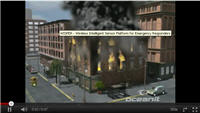
Wireless Emergency Responder Technology (With Video)
In today's world, cellular phones, Global Positioning System (GPS), WiFi, and Bluetooth are the digital signals that connect us to friends, family, and colleagues while helping us find our location and map our routes.
Yet, despite the ubiquity of such devices, with few exceptions, today's firefighters still rely on 20th-century radios, whose outdated analog signals have trouble penetrating debris and concrete. When a firefighter heroically plunges into a smoke-filled building, tunnel, or forest, a UHF radio or, for that matter, even a GPS satellite signal won't follow. The firefighter vanishes from the map.
For a first responder, radio silence can be lethal.
That's why the Department of Homeland Security's (DHS's) Science and Technology Directorate (S&T) is combining two previously developed heatproof and waterproof wireless monitors with a newly developed technology. Working together, the three technologies could lead to a life-saving solution.
One device, the Geospatial Location Accountability and Navigation System for Emergency Responders (GLANSER), crams a microwave radio, a lightweight battery, and a suite of navigation devices into a tracking device the size of a paperback book. Back at the fire truck, GLANSER's signals are received and transmitted by a small, USB-powered base station plugged into a laptop. As firefighters move from room to room and floor to floor, the laptop display animates their every step.
A second device, the Physiological Health Assessment System for Emergency Responders (PHASER), can monitor a firefighter's body temperature, blood pressure, and pulse, relaying these vitals back to the base station. If a firefighter falls or faints, fellow firefighters can race in, quickly find him, and bring him to safety, guided by GLANSER.
Like the first cordless phones, GLANSER and PHASER transmit at 900 MHz—a frequency that can penetrate walls, given a decent-sized transmitter. But because of their portable size, the transmitters are extremely modest. Their signals could be stopped by a wall, or—in a wildfire—by a wall of trees, unless relayed by routers.
That presents an infernal challenge.
What's needed is a self-powered router that can take the heat. S&T is developing a tiny throwaway router, measuring one inch square by ½ inch thick, that's waterproof and heat-resistant up to 500° F. The Wireless Intelligent Sensor Platform for Emergency Responders, or WISPER, contains a two-way digital radio, antenna, and 3-volt lithium cel
Here's how it works: Each firefighter enters a burning building with five routers loaded into a belt-mounted waterproof canister. If a firefighter steps behind concrete or beyond radio range, the base station orders his canister to drop a "breadcrumb." The dropped routers arrange themselves into a network. If a router accidentally gets kicked down a stairwell or firehosed under a couch, the WISPER network will automatically reconfigure.
To an embattled firefighter, a handful of these smart "breadcrumbs" could spell the difference between life and death.
To extract the most life from the router's tiny battery, WISPER's designers turned to a simple, low-power communications protocol, ZigBee. ZigBee is tortoise-slow by design; it trades speed for battery life, telegraphing no more than 100 kilobits per second (kbps)—a rate that's more than 99 percent slower than WiFi.
"Throw in smoke, firehose mist, stairwells, and walls, and you're down to maybe 10 kbps. But that's fast enough to tell an incident commander the whereabouts (via GLANSER) and health (via PHASER) of every firefighter in the blaze," explains Jalal Mapar, WISPER's project manager in S&T's Infrastructure Protection and Disaster Management Division. "We're not streaming video that needs a lot of bandwidth, just vital signs and coordinates."
WISPER's router, dispenser, and tiny USB base station were developed by Oceanit Laboratories, Inc., of Honolulu, and the University of Virginia's Department of Computer Science under an S&T Small Business Innovation Research (SBIR) program.
In March 2011, Oceanit and UVA demonstrated WISPER for S&T at a FEMA office in Arlington, Virginia. Simulating a squad of firefighters, three router-toting researchers fanned out, dodging around corners, stepping down stairwells. In test after test, their signals stayed strong, even at a range of 150 feet.
Now that the SBIR project is proven to be a surefire success, S&T hopes a maker will step forward to produce the routers in volume. Once a commercial entity begins production, S&T's Test & Evaluation and Standards Office will evaluate a sample product to ensure that it meets the stated performance criteria and for consistency. S&T will also set industry standards so that other manufacturers will have a set of specifications for design and performance.
"We've demonstrated that it works," says Mapar. "Now we just need a private-sector partner to add fuel to the fire."